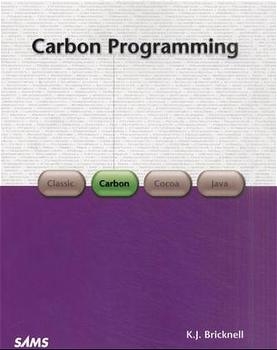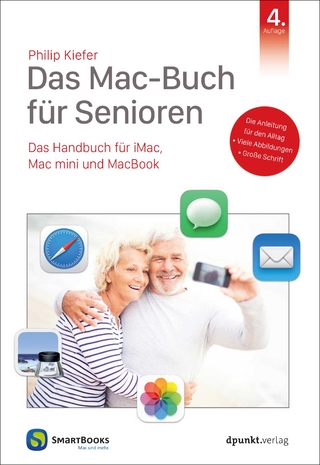
Carbon Programming
Sams Publishing (Verlag)
978-0-672-32267-9 (ISBN)
- Titel ist leider vergriffen;
keine Neuauflage - Artikel merken
Carbon Programming is a comprehensive guide that is logically organized, compatible with the current system software, and includes ready-to-run demonstration programs within each chapter. The book covers Mac programming using the Carbon API. Topics include:
Scrap;
Event Manager;
Appearance Manager;
Controls;
Lists.
This book is for Mac programmers who are familiar with the C language but who are new to the Carbon API. Professionals coming to the Macintosh and computer science students will benefit from the book as a learning tool relating specifically to the Macintosh computer and the Carbon API.
K. J. Bricknell is a retired officer of the Royal Australian Air Force. His service career included flying duties in fighter squadrons and flying training units, together with staff duties associated with operational requirements, air training, and Air Force policy and plans at the Australian Department of Defense. His commands included No 3 (Fighter) Squadron and the Aircraft Research and Development Unit. An amateur programmer for many years, he is the author of Macintosh C: A Hobbyist's Guide to Programming the Macintosh in C, which was published on the Internet in 1996.
1. System Software, PowerPC Run-Time Environment, Managing Memory, and Resources.
System Software. PowerPC Run-Time Environment. Managing Memory—Mac OS 8/9. Managing Memory—Mac OS X Considerations. Resources. Main Memory Manager Data Types and Functions. Main Resource Manager Constants, Data Types, and Functions. Demonstration Program SysMemRes Listing. Demonstration Program SysMemRes Comments.
2. The Classic Event Manager—Low-Level and Operating System Events.
The Two Event Managers. Overview of the Classic Event Model. Obtaining Information About Events. Flushing the Operating System Event Queue. Handling Events. Handling Events in Alerts and Dialogs. The 'SIZE' Resource. Main Event Manager Constants, Data Types and Functions. Demonstration Program LowEvents Listing. Demonstration Program LowEvents Comments.
3. Menus.
Introduction—Types of Menus. Pull-Down Menus. Hierarchical Menus. Pop-Up Menus. Menu Objects, Menu IDs and Item Numbers, Command IDs, and Menu Lists. Creating Your Application's Menus. Providing Help Balloons (Mac OS 8/9). Changing Menu Item Appearance. Adding Items to a Menu. Associating Data With Menu Items. Handling Menu Choices. Hiding and Showing the Menu Bar. Accessing Menus From Alerts and Dialogs. Main Menu Manager Constants, Data Types, and Functions. Demonstration Program Menus1 Listing. Demonstration Program Menus1 Comments. Demonstration Program Menus2 Listing. Demonstration Program Menus2 Comments.
4. Introduction to Windows.
Scope of This Chapter. Window Basics. Types of Windows. Window Regions. Controls and Control Lists. The Window List. The Graphics Port and the Window Object. Events in Windows. Creating Your Application's Windows. Managing Multiple Windows and Associated Data. Handling Events. Manipulating Windows. Providing Help Balloons (Mac OS 8/9). Main Window Manager Constants, Data Types, and Functions. Demonstration Program Windows1 Listing. Demonstration Program Windows1 Comments.
5. Carbon and Universal Procedure Pointers.
Introduction. The 68LC040 Emulator and the Mixed Mode Manager. Universal Procedure Pointers and Carbon. Creation/Disposal Functions Relevant to Demonstration Programs.
6. The Appearance Manager.
History. The Appearance Manager. Main Constants, Data Types, and Functions. Demonstration Program Appearance Listing. Demonstration Program Appearance Comments.
7. Introduction to Controls.
Introduction. Standard Controls. The Control Definition Function. The Basic Controls, Primary Group Boxes (Text Title Variant), and User Panes. Activating, Deactivating, Hiding, Showing, Enabling, and Disabling Controls. Visual Feedback from the Basic Controls. Embedding Controls. Getting and Setting Control Data. The Control Object. Creating Controls. Updating, Moving, and Removing Controls. Handling Mouse Events in Controls. Determining and Changing Control Settings, and Getting a Control's Kind. Moving and Resizing Scroll Bars. Scrolling Operations With Scroll Bars. Small Versions of Controls. Main Control Manager Constants, Data Types and Functions Relevant to the Basic Controls, Primary Group Box and User Panes. Demonstration Program Controls1 Listing. Demonstration Program Controls1 Comments. Demonstration Program Controls2 Listing. Demonstration Program Controls2 Comments.
8. Dialogs and Alerts.
Introduction. Alert Types, Modalities, and Levels. Dialog Types and Modalities. Window Types for Alerts and Dialogs. Content of Alerts and Dialogs. Removing Dialogs. Creating and Removing Alerts. Creating Dialogs. Items in Dialogs. Displaying Alerts and Dialogs. Handling Events in Alerts and Dialogs. Closing and Disposing of Dialogs. Creating Displaying and Handling Window-Modal (Sheet) Alerts and Dialogs. Balloon Help for Dialogs—Mac OS 8/9. Help Tags for Dialogs—Mac OS X. Main Dialog Manager Constants, Data Types and Functions. Relevant Window Manager Functions (Mac OS X Only). Demonstration Program DialogAndAlerts Listing. Demonstration Program DialogsAndAlerts Comments.
9. The Finder and the Application.
Introduction. An Application's Required Resources. Application Signature, File Creator, and File Types. Icons for the Finder. File Reference ('FREF') Resources. The Bundle ('BNDL') Resource. The Version ('vers') Resource. Finder Icon Help ('hfdr') Resource—Mac OS 8/9. Missing Application and Application-Missing Resources— Mac OS 8/9. The 'plst' Resource and Information Property Lists. Application Launching by the Finder. The Finder and the Catalog File. Preferences, Temporary Items, and Trash Folders— Using FindFolder. Stationery Pads. Using Aliases. Mac OS 9 Packages and Mac OS X Bundles. Relevant Constants, Data Types, and Functions. Demonstration Programs.
10. Apple Events.
Introduction. Apple Event Attributes and Parameters. Data Structures Within Apple Events. Handling Apple Events. Required Apple Events—Contents and Required Action. Main Apple Event Manager and Appearance Manager Constants, Data Types, and Functions Relevant to Required Apple Events and Appearance Manager Apple Events. Demonstration Program AppleEvents. Demonstration Program AppleEvents Comments.
11. QuickDraw Preliminaries.
QuickDraw and Imaging. RGB Colors and Pixels. Color and the Video Device. Graphics Port. Translation of RGB Colors to Pixel Values. Graphics Devices and GDevice Structures. Other Graphics Managers. Coping with Multiple Monitors. Relevant QuickDraw Constants, Data Types, and Functions. Demonstration Program PreQuickDraw Listing. Demonstration Program PreQuickDraw Comments.
12. Drawing with QuickDraw.
Introduction. The Coordinate Plane, Points, Rectangles, and Regions. The Graphics Pen, Foreground and Background Colors, Pixel Patterns and Bit Patterns, and Transfer Modes. Drawing Lines and Framed Shapes. Drawing Painted and Filled Shapes. Erasing and Inverting Shapes. Drawing Pictures. Drawing Text. Copying Pixel Images Between Graphics Ports. Scrolling Pixels in the Port Rectangle. Manipulating Rectangles and Regions. Highlighting. Drawing Other Graphics Entities. Saving and Restoring the Graphics Port Drawing State. Main QuickDraw Constants, Data Types and Functions. Relevant Appearance Manager Data Types and Functions. Demonstration Program QuickDraw Listing. Demonstration Program QuickDraw Comments.
13. Offscreen Graphics Worlds, Pictures, Cursors, and Icons.
Offscreen Graphics Worlds. Pictures. Cursors. Icons. Main Constants, Data Types and Functions—Offscreen Graphics Worlds. Main Constants, Data Types and Functions—Pictures. Main Constants, Data Types and Functions—Cursors. Appearance Manager Constants, Data Types and Functions—Cursors. Main Constants, Data Types and Functions—Icons. Demonstration Program GworldPicCursIcn Listing. Demonstration Program GWorldPicCursIcn Comments.
14. More on Controls.
Introduction. Control Descriptions. Small Versions of Controls. Idle Processing. Defining Your Own Key Filter Function. Defining Your Own Edit Text Validation Function. Defining Your Own User Pane Functions. Main Constants, Data Types and Functions. Demonstration Program Controls3 Listing. Demonstration Program Controls3 Comments.
15. Carbon Printing.
The Carbon Printing Manager. Printer Drivers. Page and Paper Rectangles. Page Setup Dialogs and Print Dialogs. Printing Sessions—The PMPrintSession Object. The PMPageFormat and PMPrintSettings Objects. Printing a Document. Text on the Screen and the Printed Page. Customizing the Page Setup and Print Dialogs. Displaying Page Setup and Print Dialogs As Window-Modal (Sheet) Dialogs. Saving and Retrieving a Page Format Object. Printing from the Finder—Mac OS 8/9. Main Carbon Printing Manager Constants, Data Types and Functions. Demonstration Program CarbonPrinting Listing. Demonstration Program CarbonPrinting Comments.
16. More on Windows.
Introduction. Floating Windows. Utility and Toolbar Windows. Window Proxy Icons. Window Path Pop-Up Menus. Transitional Window Animation and Sounds. Creating and Storing Windows. Accessing Window Information. Moving and Positioning Windows. Associating Data with Windows. Adding To and Removing From the Update Region. Setting Content Region Color and Pattern. Window Scrolling. The Window Menu. Live Window Resizing. Main Constants, Data Types, and Functions. Demonstration Program Windows2 Listing. Demonstration Program Windows2 Comments.
17. The Carbon Event Manager.
Overview. Event Reference, Class, and Type. Standard Event Handlers. The Application's Event Handlers. Sending and Explicitly Propagating Events. Event Timers. Getting Event Time. Other Aspects of the Carbon Event Model. Main Constants, Data Types, and Functions. Relevant Window Manager Constants and Functions. Demonstration Program CarbonEvents1 Listing. Demonstration Program CarbonEvents1 Comments. Demonstration Program CarbonEvents2 Listing. Demonstration Program CarbonEvents2 Comments.
18. Files and Navigation Services.
Introduction. Files. Navigation Services. Main File Manager Constants, Data Types and Functions. Relevant Resource Manager Functions. Relevant Finder Interface Functions. Main Navigation Services Constants, Data Types, and Functions. Demonstration Program Files Listing. Demonstration Program Files Comments.
19. More on Resources and Core Foundation Preferences.
Introduction. Search Path for Resources. Releasing and Detaching Resources. Creating, Opening, and Closing Resource Forks. Reading and Manipulating Resources. Writing Resources. Partial Resources. Application Preferences. Main Resource Manager Constants, Data Types and Functions. Main Core Foundation Preferences Services Functions. Demonstration Program MoreResources Listing. Demonstration Program MoreResources Comments.
20. Carbon Scrap.
The Carbon Scrap Manager and the Scrap. Private Scrap. TextEdit, Dialogs, and Scrap. Main Carbon Scrap Manager Constants, Data Types, and Functions. Demonstration Program CarbonScrap Listing. Demonstration Program CarbonScrap Comments.
21. Text, Textedit, Dates, Times, and Numbers.
Introduction. More on Text. Introduction to TextEdit. Monostyled TextEdit. Multistyled TextEdit. Formatting and Displaying Dates, Times, and Numbers. Main TextEdit Constants, Data Types and Functions. Main Constants, Data Types and Functions Relating to Dates, Times and Numbers. Demonstration Program MonoTextEdit Listing. Demonstration Program MonoTextEdit Comments. Demonstration Program DateTimeNumbers Listing. Demonstration Program DateTimeNumbers Comments.
22. Lists and Custom List Definition Functions.
Introduction to Lists. Appearance and Features of Lists. Selection of Cells Using the Mouse. Selection of Cells Using the Keyboard. Creating, Disposing of, and Managing Lists. The List Box Control. Custom List Definition Functions. Main List Manager Constants, Data Types, and Functions. Relevant Text Utilities Data Type and Functions. Demonstration Program Lists Listing. Demonstration Program Lists Comments.
23. Drag and Drop.
Overview. Drag Items, Drag Item Flavors, and Handlers. The Drag Region and The Drag Image. Drag Functions—Overriding Drag Manager Default Behavior. Main Drag Manager Constants, Data Types, and Functions. Relevant TextEdit Function. Demonstration Program Drag Listing. Demonstration Program Drag Comments.
24. Basic Sound and Speech.
Introduction to Sound. Sound Production. Sound Recording—Mac OS 8/9. Speech. Relevant Constants, Data Types, and Functions. The AsynchSoundLib Library. Demonstration Program SoundAndSpeech Listing. Demonstration Program SoundAndSpeech Comments.
25. Miscellany.
Notification From Applications in the Background. Progress Bars Command-Period Key-Down Events, and Mouse-Down Events. The Color Picker. Coping with Multiple Monitors. Help Tags. Ensuring Compatibility with the Operating Environment. Carbon and Available APIs. Main Notification Manager Data Types and Functions. Relevant Process Manager Data Types and Functions. Relevant Event Manager Function. Relevant Color Picker Utilities Function. Relevant QuickDraw Function. Relevant Window Manager Function. Main Help Package Constants, Data Types, and Functions. Relevant Gestalt Manager Function. Demonstration Program Miscellany Listing. Demonstration Program Miscellany Comments.
26. More on Text—Multilingual Text Engine.
Introduction. Working with MLTE. Main Constants, Data Types, and Functions. Demonstration Program MLTETextEditor Listing. Demonstration Program MLTETextEditor Comments.
Index.
| Erscheint lt. Verlag | 29.10.2001 |
|---|---|
| Verlagsort | Indianapolis |
| Sprache | englisch |
| Maße | 188 x 233 mm |
| Gewicht | 2282 g |
| Themenwelt | Informatik ► Betriebssysteme / Server ► Macintosh / Mac OS X |
| Mathematik / Informatik ► Informatik ► Programmiersprachen / -werkzeuge | |
| ISBN-10 | 0-672-32267-6 / 0672322676 |
| ISBN-13 | 978-0-672-32267-9 / 9780672322679 |
| Zustand | Neuware |
| Haben Sie eine Frage zum Produkt? |
aus dem Bereich


